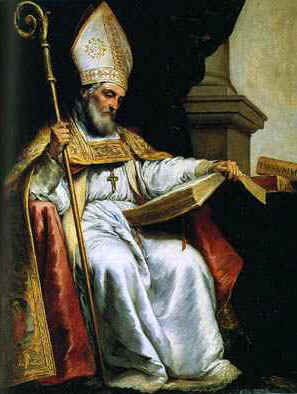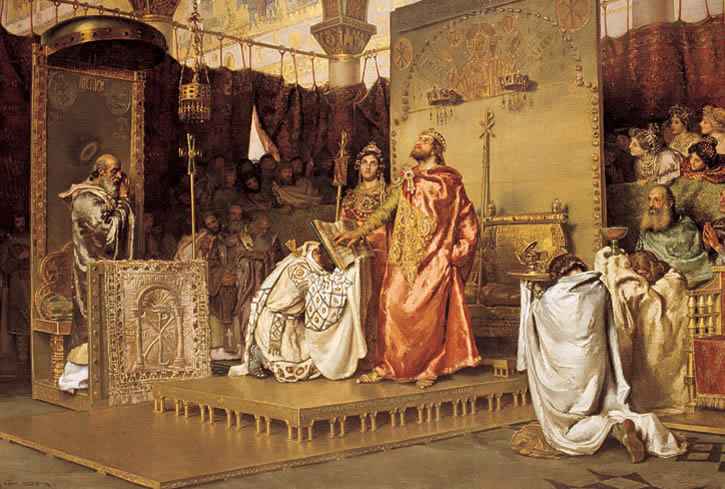

The Church presents to us today, for our devout admiration, the memory of one of the holiest of Her Bishops – Isidore, the Bishop of Seville, the most learned man of his age, and what is a still greater praise, the most zealous patriot and friend of his noble country. He comes to speak to us upon the glories of our Risen Jesus. The Gothic or Mozarabic Liturgy, which has given us such admirable prayers for the Easter Season, was drawn up mainly by St. Isidore.
Among Christian lands there is one that has gained for herself the glorious name of The Catholic Kingdom. Towards the close of the 7th century Divine Providence subjected her to a most severe trial, by permitting the Saracen hordes to invade her: so that her heroic children had to struggle, for 800 years, for the recovery of their country. Contemporaneously with Spain, much of Asia and Africa also fell under the Muslim yoke, and have continued in their slavery up to the present day. Whence comes it that Spain triumphed over her oppressors? The answer is easily given: Spain, at the period of her invasion, was Catholic, and Catholicity was the very spirit of the land; whereas those other nations, that yielded themselves slaves to the Saracens, were already separated from the Catholic Church by heresy or schism. God abandoned them, because they rejected both the truth of Faith, and unity with the Church; they fell an easy prey to the infidel conqueror.
Nevertheless, Spain had incurred an immense risk. The race of the Goths, by their long invasion of her territory, had sowed the seeds of heresy: Arianism had set up its sacrilegious altars in Iberia. But God did not permit this privileged country to be long under the yoke of error. Before the Saracens came upon her, she had been reconciled to the Church; and God had chosen one family to be the glorious instrument in the completion of this great work. Even to this day, the traveller through Andalusia will find the squares of its cities adorned with four statues: they are those of three brothers and a sister-St. Leander, Bishop of Seville; St. Isidore, whose feast we are keeping today; St. Fulgentius, Bishop of Cartagena; and the sister St. Florentina, a nun. It was by the zeal and eloquence of St. Leander that King Reccared and his Goths were converted from Arianism to the Catholic Faith, in the year 589; the learning and piety of our glorious Isidore consolidated the great work; St. Fulgentius gave it stability by his virtues and erudition; and St. Florentina co-operated in it by her life of sacrifice and prayer.

King Reccared abjures his heresy before St. Leander.
Let us unite with the ancient Catholic Kingdom in honoring this family of Saints; and today, in a special manner, let us pay the tribute of our devotion to St. Isidore. The holy Liturgy thus speaks of him:
Isidore, by birth a Spaniard, was an illustrious Doctor of the Church. He was born at Cartagena, and his father, whose name was Severianus, was governor of that part of the country. He was solidly trained to piety and learning by his two brothers, Leander, Bishop of Seville, and Fulgentius, Bishop of Cartagena. He was taught Latin, Greek and Hebrew; he was put through a course of canon and civil law; and there was no science or virtue in which he did not excel. Whilst yet a youth, he so courageously combated the Arian heresy, which had long infected the Goths who had entered Spain, that it was with difficulty that he escaped being put to death by the heretics. After the death of St. Leander, he was, though he was reluctant, raised to the Episcopal See of Seville, by the influence of King Reccared, and with unanimous consent of both clergy and people. Not only was his election confirmed by Apostolic authority, but St. Gregory the Great, when sending him, as usual, the pallium, is said to have appointed him his own vicar, and that of the Apostolic See throughout all Spain.
It would be impossible to describe the virtues of Isidore as Bishop; how firm, humble, patient, and merciful he was; how zealously he labored for the restoration of Christian morals and ecclesiastical discipline, and how untiring he was in his efforts, both by word and writing, to establish them among his people; and finally, how he excelled in every virtue. He was a fervent promoter of the monastic life in Spain, and built several monasteries. He also built colleges, in which he applied himself to teaching the sacred sciences to the many disciples that flocked to him; among whom may be mentioned those two glorious Pontiffs, St. Ildephonsus, Bishop of Toledo, and St. Braulio, Bishop of Zaragoza. In a Council held at Seville, he spoke with such power and eloquence that he may be said to have destroyed the heresy of the Acephali, who were threatening to destroy the true Faith in Spain. So great, indeed, was the universal reputation he had gained for piety and learning, that he had scarcely been dead 16 years, when, in a Council held at Toledo, at which 52 bishops were present, St. Ildephonsus being among them, he was called the Illustrious Doctor, the new glory of the Catholic Church, the most learned man who had been seen in those ages, and one whose name should never be mentioned but with great respect. St. Braulio not only compared him to St. Gregory the Great, but said that he looked on him as having been sent by Heaven, as a second St. James, to instruct the people of Spain.
St. Isidore wrote a book On Etymologies, and another On Ecclesiastical Offices, and several others, of such importance to Christian and ecclesiastical discipline, that Pope St. Leo IV did not hesitate to say in a letter addressed to the bishops of Britain, that one ought to adhere to the words of St. Isidore with the same respect as to those of St. Jerome and St. Augustine, as often as a difficult case which could not be settled by Canon Law should arise. Several sentences of his works have been inserted into the body of Canon Law. He presided over the Fourth Council of Toledo, which is the most celebrated of all those that have been held in Spain. At length, after having driven the Arian heresy out of Spain, he publicly foretold the day of his death, and the devastation of the country by the Saracens; and having governed his see for about 40 years he died at Seville, in the year 636. His body was first buried, as he himself had requested, between those of his brother and sister, Ss. Leander and Florentina. Afterwards Ferdinand I, King of Castile and Leon, ransomed it, with a large sum of money, from Enetus, the Saracen governor of Seville, and had it translated to Leon. Here a church was built in his honor, and the miracles that are wrought by his intercession have led the people to honor him with great devotion.
Contact us: smr@salvemariaregina.info
Visit also: www.marienfried.com